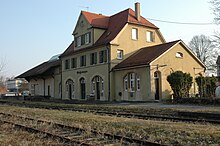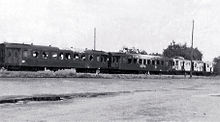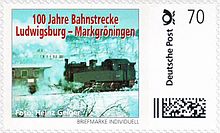Ludwigsburg – Markgröningen railway line
| Ludwigsburg – Markgröningen | |||||||||||||||||||||||||||||||||||||||||||||||||||||||||||||||||||||||||||||||||||||||||||||
|---|---|---|---|---|---|---|---|---|---|---|---|---|---|---|---|---|---|---|---|---|---|---|---|---|---|---|---|---|---|---|---|---|---|---|---|---|---|---|---|---|---|---|---|---|---|---|---|---|---|---|---|---|---|---|---|---|---|---|---|---|---|---|---|---|---|---|---|---|---|---|---|---|---|---|---|---|---|---|---|---|---|---|---|---|---|---|---|---|---|---|---|---|---|
| Route number (DB) : | 4831 | ||||||||||||||||||||||||||||||||||||||||||||||||||||||||||||||||||||||||||||||||||||||||||||
| Course book section (DB) : | 315c (1944) 320h (?) 773 (1975) |
||||||||||||||||||||||||||||||||||||||||||||||||||||||||||||||||||||||||||||||||||||||||||||
| Route length: | 8.35 km | ||||||||||||||||||||||||||||||||||||||||||||||||||||||||||||||||||||||||||||||||||||||||||||
| Gauge : | 1435 mm ( standard gauge ) | ||||||||||||||||||||||||||||||||||||||||||||||||||||||||||||||||||||||||||||||||||||||||||||
| Maximum slope : | 17 ‰ | ||||||||||||||||||||||||||||||||||||||||||||||||||||||||||||||||||||||||||||||||||||||||||||
| Minimum radius : | 300 m | ||||||||||||||||||||||||||||||||||||||||||||||||||||||||||||||||||||||||||||||||||||||||||||
|
|||||||||||||||||||||||||||||||||||||||||||||||||||||||||||||||||||||||||||||||||||||||||||||
The railway Ludwigsburg Markgröningen is a 1916 opened standard gauge branch line in the district of Ludwigsburg . On the eastern part of the former 8.35-kilometer branch line from Ludwigsburg via Möglingen to Markgröningen , only freight traffic now takes place; the western part of the line has been closed since 2005.
history
Design and construction
In the competition with Bietigheim for the routing of the " Westbahn " from Ludwigsburg to Mühlacker , Markgröningen was left out in the 1840s - despite more favorable topographical conditions. The originally favored route through the Leudelsbachtal would not only have been shorter, but would also have enabled a gentle descent into the Enz Valley that was suitable for the railways and would have avoided the expensive construction of the Bietigheimer railway viaduct . On the part of the bypassed Markgröningen, allegations of corruption arose. In order to avoid the observed stagnation, the Markgröningen magistrate had a branch line from Asperg to Markgröningen planned around 1890 , but this was unsuccessful.
Finally, on March 1, 1898, the “Committee for the Construction of a Railway Ludwigsburg – Vaihingen ad E.” submitted an application to the High Estates Assembly in Stuttgart for a narrow-gauge railway from Ludwigsburg via Eglosheim, Asperg, Markgröningen, Unter- and Oberriexingen , Enzweihingen , Vaihingen the Enz to Sersheim with a junction from Enzweihingen via Riet to Eberdingen . Enclosed was a cost estimate for 1,649,000 marks, a detailed profitability calculation, which compared the expected operating income in passenger, freight, wagonload and cattle traffic with the expected operating expenses, as well as a map of the planned route. After the application was rejected, the municipalities of Ludwigsburg, Möglingen and Markgröningen applied for the construction of a standard-gauge state railway from Ludwigsburg via Möglingen to Markgröningen on April 23, 1908. In order to win the “High Royal State Government” and the “High Estates Assembly” for the slimmed-down project, the participating municipalities agreed to purchase the land for the State Railroad and to bring in an additional construction subsidy of 10,000 marks per kilometer. Due to the planned further construction through the Leudelsbachtal in the apron of Markgröningen, the line was opened on December 4th, 1916 by the Royal Württemberg State Railways . The connection via Unterriexingen and Oberriexingen to the Vaihingen – Enzweihingen railway line, inaugurated in 1904, was never realized.
passenger traffic
In 1944, twelve regular passenger trains with 3rd class cars left Markgröningen on weekdays. It took 19 minutes to get to Ludwigsburg, with two stops in Möglingen and at Osterholz. On March 13, 1945, French fighter pilots bombed the locomotive of the after-work train leaving Markgröningen and fired at the passengers. There were 24 deaths, including the four-person train crew, and around 50 injured, mainly employees of the Krone and Porsche production facilities relocated to Markgröningen, as well as some Russian prisoners of war.
Locomotive 94.107 on postage stamp for the 2016 anniversary
From the 1950s, the Deutsche Bundesbahn began to carry out rationalization measures on the route and to thin out passenger traffic. Together with the local council and the city administration, the then more than 1000 commuters demanded in vain that the train should continue. On September 28, 1975, the Deutsche Bundesbahn stopped regular passenger traffic and switched the route to rail buses . The Württembergische Bus-Gesellschaft has been operating the route since 2019 .
For the 75th anniversary of the route, the BUND district association Ludwigsburg combined its nature conservation day with a station festival organized by Markgröning associations in order to win over the invited members of parliament and local councils to reactivate passenger transport using the diesel multiple units presented by the VCD . Together with the Pro Ermstalbahn initiative , the BUND local association in Markgröningen organized several special train services with n-wagons of the Deutsche Bundesbahn after 1991 , each to the shepherd runs in Bad Urach and Markgröningen with local shuttle services between the journey there and back.
The town of Markgröningen took over the annual shuttle service between Ludwigsburg and Markgröningen on the occasion of the Markgröninger Schäferlauf after the railway reform of 1994. Up until 1995, when a set of the 628/928 series of the Deutsche Bahn AG was in use, railcars of the Württembergische Eisenbahn-Gesellschaft (WEG) were used: initially of the type NE 81 , later more modern vehicles of the type Regio-Shuttle , last on 24 and August 25, 2002. The special traffic planned for the 2003 Schäferlauf had to be canceled again at short notice because of the poor condition of the track, although the official timetable had already been published.
Freight transport
After the sugar beet transport and general cargo delivery had been shifted to the road and the C&A distribution center in Markgröningen, which was connected by an industrial track, was closed in 2001, there was no longer any regularly served goods customer in Markgröningen. Deutsche Bahn AG therefore announced that it would completely stop regular freight traffic to Markgröningen on September 27, 2001. However, even after the departure of C&A, Markgröningen was still served in freight transport, but now only sporadically as required - most recently in March 2002. The very last trip of a train to Markgröningen was then the transport of a large transformer for the substation near Pulverdingen on Monday, November 11th August 2003, as an unscheduled special train .
Shutdown
Then the Deutsche Bahn AG applied to the Federal Railway Authority for the closure of the section between the connection of the Ludwigsburg company Lotter and the terminal station in Markgröningen. This application was finally granted on August 24, 2005. The western section of the route was formally closed on October 1, 2005. This shutdown was necessary, among other things, in order to be able to start construction of the second section of the Markgröninger bypass . For this purpose, a short section of the railway embankment in front of Markgröningen had to be dismantled, but with this construction measure a possible reactivation was taken into account. As a preliminary construction work, the new road runs in a six-meter-deep cut - and thus three meters deeper than the route of the road requires; the railway could cross the street with a bridge in the future.
Todays situation
In the course of the closure of the western section, the remaining eastern section, which continues to run as far as the Lotter company , was formally rededicated to a station track at Ludwigsburg station and leased to Lotter . Lotter is still supplied with liquid gas in tank wagons once a working day . Separately, Lotter has a second siding on the Ludwigsburg industrial line a little further east . The Markgröningen station is a listed building as a whole .
Reactivation discussion
The concept for reactivating passenger traffic presented by BUND and VCD in 1991 envisaged a daily 15-hour operation with low-floor railcars, which should run between Ludwigsburg and Markgröningen every half hour with two stops in Möglingen. To achieve this, the line would have had to be rehabilitated and the level crossings that had to be operated manually by the train crew had to be automated.
Since 1992, the public authorities have commissioned various studies to examine the potential and possible structure of passenger transport. All plans include an additional breakpoint in Möglingen in the east of the town, where the focus of settlement development was in the last decades of the 20th century. In addition to operation between the current line end points, some expansion variants have been discussed so far. Operation as part of the proposed Ludwigsburg tram according to the rules of BOStrab is also an option.
From Markgröningen:
- New line to Schwieberdingen to the development center of Robert Bosch GmbH
From Ludwigsburg:
- Construction of a new line to Remseck with a connection to the Stuttgart city railway . The Ludwigsburg district of Oßweil or Pattonville, which belongs to Kornwestheim and Remseck, would be connected. There are also plans to continue the route beyond Remseck to Waiblingen and thus create a tangential connection in the northeast of the Stuttgart area.
- Connection of the trains to Kornwestheim passenger station with the possibility of continuing via the Schusterbahn to Esslingen (Neckar) or via the “Salzweg branch” to Korntal or Leonberg .
There are both supporters and opponents in the neighboring communities. Opponents based in Möglingen, in particular, suggest expanding the bus network as an alternative. In Markgröningen, the majority of the population is in favor of a quick reactivation. Ludwigsburg-based supporters of a light rail network do not want to reactivate the rail network prematurely because they fear that the low-floor light rail system will not be eligible for funding. In contrast to the establishment of a light rail, there is no need for a complex approval process to reactivate rail operations, because the disused part of the railway line is still dedicated. Objections would therefore be hopeless.
Double strategy
On May 3, 2017, the Ludwigsburg municipal council voted unanimously in favor of the "dual strategy" agreed in the State Ministry of Transport, which initially required an immediate reactivation and extension of the railway line via a new stop at the expanded W&W headquarters to Kornwestheim and in the Ludwigsburg city area BRT express buses . The railway line will later be used in mixed operation of the railway (in accordance with the railway building and operating regulations ) and low-floor light rail (in accordance with the tram building and operating regulations ). In July 2017, the Kornwestheim municipal council and the Ludwigsburg district council also voted unanimously in favor of reactivating the railway line as part of the dual strategy. On February 27, 2018, the Markgröningen municipal council voted unanimously in favor of reactivating the railways as part of the dual strategy. It is planned to use electrically operated local railcars without overhead lines, either with fuel cells or batteries, which could be fed from the overhead line during the journey between Ludwigsburg and Kornwestheim.
literature
- Rainer Christmann: Comparison of EBO and BOStrab: reactivation of the railway or new construction of a light rail? In: Through the city glasses - historical research, stories and preservation of monuments in Markgröningen , Volume 10, ed. v. AGD Markgröningen, p. 24, Markgröningen 2016, ISBN 978-3000539077 .
- Peter Fendrich u. David Zechmeister: One hundred years of Gröninger Zügle - review of the reactivation of the Ludwigsburg – Markgröningen railway line . In: Through the city glasses - historical research, stories and preservation of monuments in Markgröningen , Volume 10, ed. v. AGD Markgröningen , pp. 6–25, Markgröningen 2016, ISBN 978-3000539077 .
- Heinz Keck: The development of the railway. In: 1200 Jahre Markgröningen 779 to 1979, Volume 1. Markgröningen 1979, pp. 92-94.
- Markgröningen - people and their city. Comprehensive presentation of the city's recent history in approx. 60 individual articles . Volume 6 of the series "Durch die Stadtbrille", ed. v. AGD Markgröningen, Markgröningen 2000
- Peter-Michael Mihailescu, Matthias Michalke: Forgotten railways in Baden-Württemberg . Konrad Theiss Verlag, Stuttgart 1985, ISBN 3-8062-0413-6 , p. 164-165 .
- Hans-Wolfgang Scharf: The railway in Kraichgau. Railway history between the Rhine and Neckar . EK-Verlag, Freiburg (Breisgau) 2006, ISBN 3-88255-769-9 .
Web links
- History of the route and gallery for the route on the website of the Working Group on Historical Research and Monument Preservation Markgröningen (AGD)
- Information from the city of Ludwigsburg on the dual strategy (rail reactivation + low-floor tram)
- Information on reactivation of the railway on the website of the citizens' initiative local recreation instead of the northern bypass in Markgröningen
- Description of the route on forget-bahnen.de
- Description of the route on geralds-bahnseiten.de
Individual evidence
- ↑ Heinz Keck: The development of the railway. In: 1200 Jahre Markgröningen 779 to 1979, Volume 1, Markgröningen 1979, pp. 92-94.
- ↑ Heinz Keck: The development of the railway. In: 1200 Jahre Markgröningen 779 to 1979, Volume 1, Markgröningen 1979, pp. 92-94.
- ↑ Excerpt from the course book from 1944
- ^ Markgröningen - people and their city. , Volume 6 of the series "Durch die Stadtbrille", ed. from the Working Group on Historical Research, Heritage and Monument Preservation Markgröningen, Markgröningen 2000, p. 328 ff.
- ↑ Postage stamp for the 100th anniversary of the railway
- ↑ Peter Fendrich u. David Zechmeister: One hundred years of Gröninger Zügle - review of the reactivation of the Ludwigsburg – Markgröningen railway line . In: Through the city glasses ... , Volume 10, Markgröningen 2016, pp. 6–25.
- ↑ Special train timetable for the Schäferlauf from August 2001 (PDF file; 16 kB)
- ↑ Planned special train timetable for the Schäferlauf from August 2003 (PDF file; 129 kB)
- ↑ List of cultural monuments in Baden-Württemberg, municipality of Markgröningen, p. 3
- ↑ a b Stuttgarter Zeitung of February 9, 2006
- ↑ Feasibility study for a tram tangential line Ludwigsburg – Waiblingen (PDF; 3.0 MB), Switch Traffic Consult GmbH, September 2007
- ↑ Points for light rail are set ( memento of the original from June 24, 2008 in the Internet Archive ) Info: The archive link was automatically inserted and not yet checked. Please check the original and archive link according to the instructions and then remove this notice. , Stuttgarter Zeitung Online, June 23, 2008
- ^ Rainer Christmann: Comparison of EBO and BOStrab: reactivation of the railway or new construction of a light rail? In: Through the city glasses ... , Volume 10, Markgröningen 2016, p. 24.
- ^ Video from the city of Ludwigsburg on the dual strategy (2 min.).
- ↑ See municipal council resolution on the city of Ludwigsburg's local rail passenger transport concept
- ↑ Ludwigsburg newspaper of July 18, 2017
- ↑ Resolution of February 27, 2018 in the Council Information System








